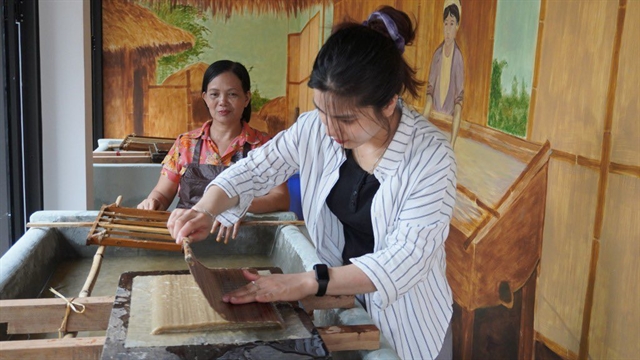 Life & Style
Life & Style


|
| The workshop on traditional dó (poonah) paper attracts many young people. — VNA/VNS Photo Minh Ngọc |
HÀ NỘI — A workshop introducing the history and production of traditional dó (poonah) paper while offering participants a hands-on opportunity to create products from the material has drawn a large number of young people.
The event, Dó It Now, held at the Dó Paper House on 189 Trích Sài Street in Hà Nội’s Tây Hồ Ward, is part of the GenZó: GenZ Meets Dó project, which aims to introduce the traditional paper to the youth through accessible, creative formats that align with contemporary trends.
A representative of the organisers, Trịnh Hải Yến, said the event demonstrates that dó paper is not only a heritage of the past but continues to thrive and evolve alongside the lifestyle of the youth.
“The initiative stems from the project's survey results, which showed that 52 per cent of respondents had never heard of dó paper, while 82 per cent expressed a desire to experience traditional products in new ways,” she said.
A participant of the workshop, Bùi Thu Phương, a fourth-year student at the University of Economics, Việt Nam National University, shared her excitement at experiencing the process of making dó paper firsthand.
“Creating a sheet of dó paper requires meticulous and skillful effort from the artisans. Many steps that seem simple actually demand careful attention, such as draining the water to achieve the right dryness or rolling the paper evenly. After creating my own product, I admired even more the talent of the traditional dó paper makers,” she said.
Đậu Hoàng Tân from Thanh Hóa Province expressed his deep appreciation for dó paper, describing it as a significant cultural element of Việt Nam that embodies many stories about the history and life of the Vietnamese people.
He also expressed regret that the paper remains relatively unknown or underappreciated.
“I hope that through cultural events like Dó It Now, along with the influence of media and community support, efforts to preserve and promote the value of dó paper will continue to improve. I believe the value and applicability of dó paper extend beyond the past and can thrive in the present and future,” he said.

|
| A student tries making dó paper at Dó Paper House. — Photo Tây Hồ 360 Facebook |
According to Dr Trần Hoài, a cultural anthropology expert, the youth's interest in dó paper reflects a positive shift in awareness regarding heritage. He appreciated the efforts of students in proactively researching and implementing the project based on a solid academic foundation, viewing this as a positive sign for heritage education efforts.
Tây Hồ Ward, formerly known as Bưởi Ward, was renowned for producing lightweight, durable poonah paper. Due to these qualities, it was used for printing scriptures, writing texts, folk paintings and, most notably, royal proclamations and decrees during the feudal dynasties in Việt Nam. Many temples, pagodas and villages still preserve the royal seals made on poonah paper.
By the early 2000s, the decline of paper cooperatives and the rise of modern materials pushed dó paper making to the brink of extinction. With the aim of reviving the traditional craft, the People’s Committee of Bưởi Ward (present-day Tây Hồ Ward) opened a cultural tourism and traditional craft promotion space for dó paper making at 189 Trích Sài Street in 2024. More than a showcase, this space serves as a living museum where visitors can explore, observe and even take part in the papermaking process guided by local artisans. — OVN/VNS




